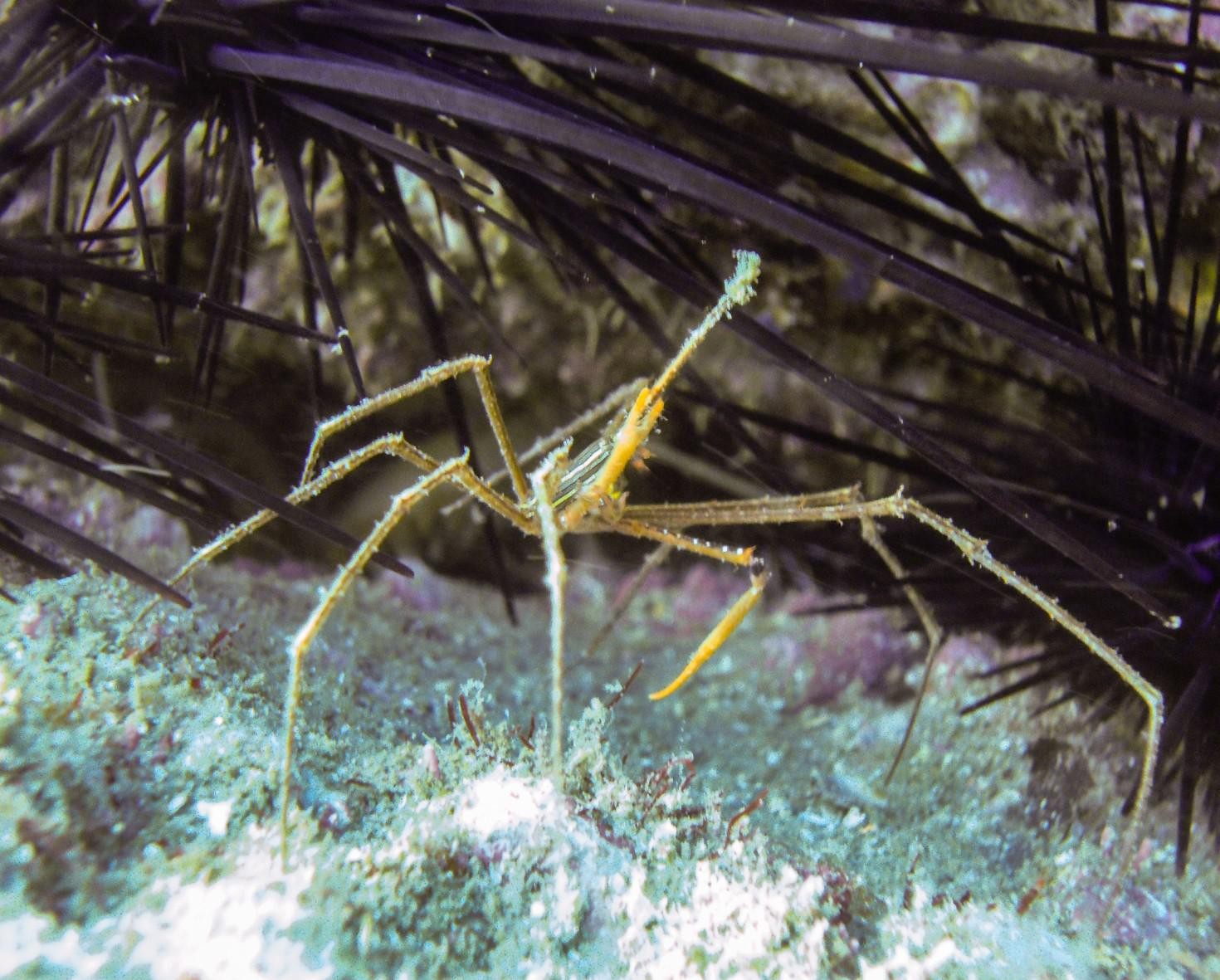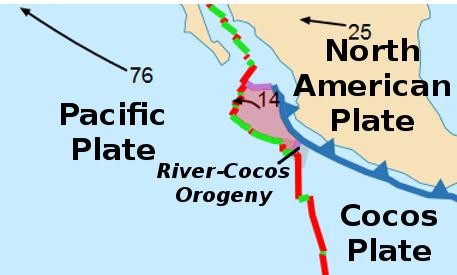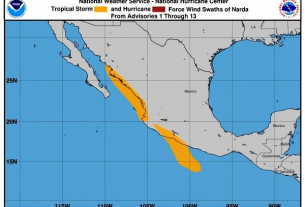By Terry Sovil from the December 2017 Edition
In Part 1, we talked about Christmas Tree Worms, Tube Blennies, Sea Cucumbers and Tiger Snake Eels. Those are critters I look for and enjoy watching on every dive. Manzanillo has a very extensive and diverse sea life. I have my favorites and love to visit with them every chance I get. This week, we meet another three characters I really enjoy, the Yellowline Arrow Crab, Octopus and Sea Horses. For all of these, you need to swim slow and search carefully. Kick less, glide more! Most of the photos here are taken by Nathan Peach.
Yellowline Arrow Crab
The Panamic arrow crab is an invertebrate. It is named because of its head and body which looks like an arrow head. They have extremely long legs. It is known to feed on bristle worms as well as feather dusters. It inhabits small caves or crevices. I see them regularly in a symbiotic relationship with spiny sea urchins, hiding among the spines.
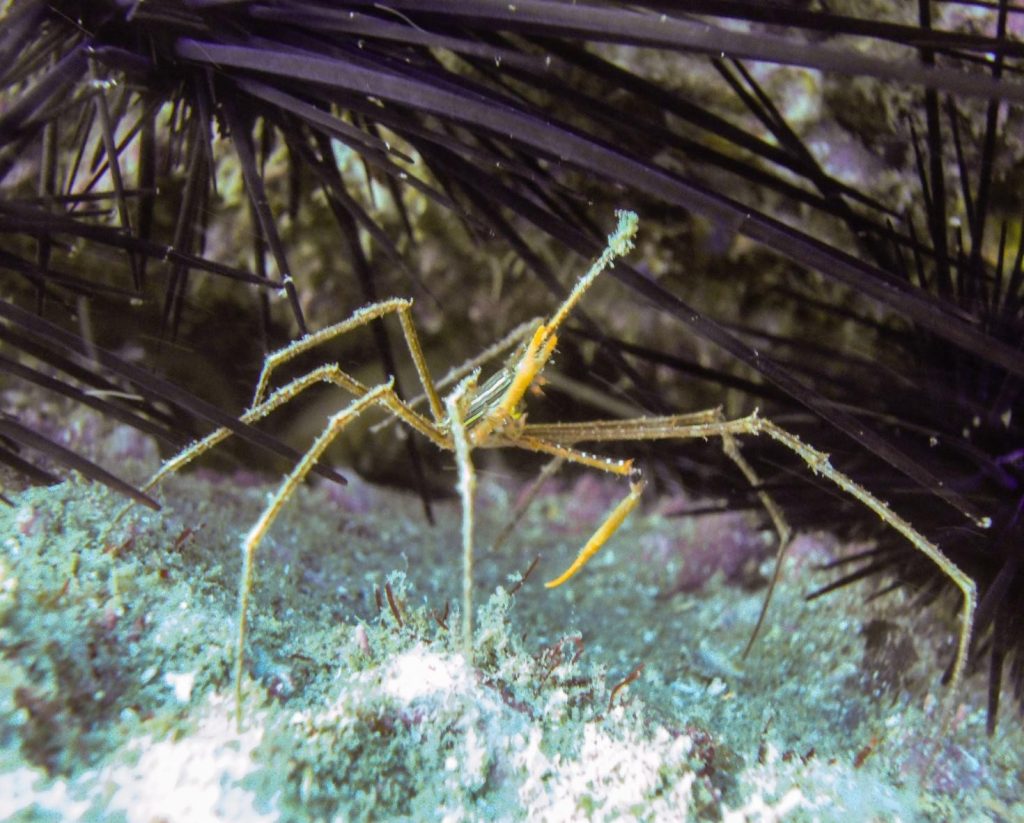
Their pointed nose is long and slender; eyes protrude on stalks and they are a Decapod with 10 legs, eight for walking and two pincers. The carapace, protective upper shell covering a crab, can reach lengths up to 2.4 inches (6 cm) and the legs can be more than three times its body length. Males are larger than females.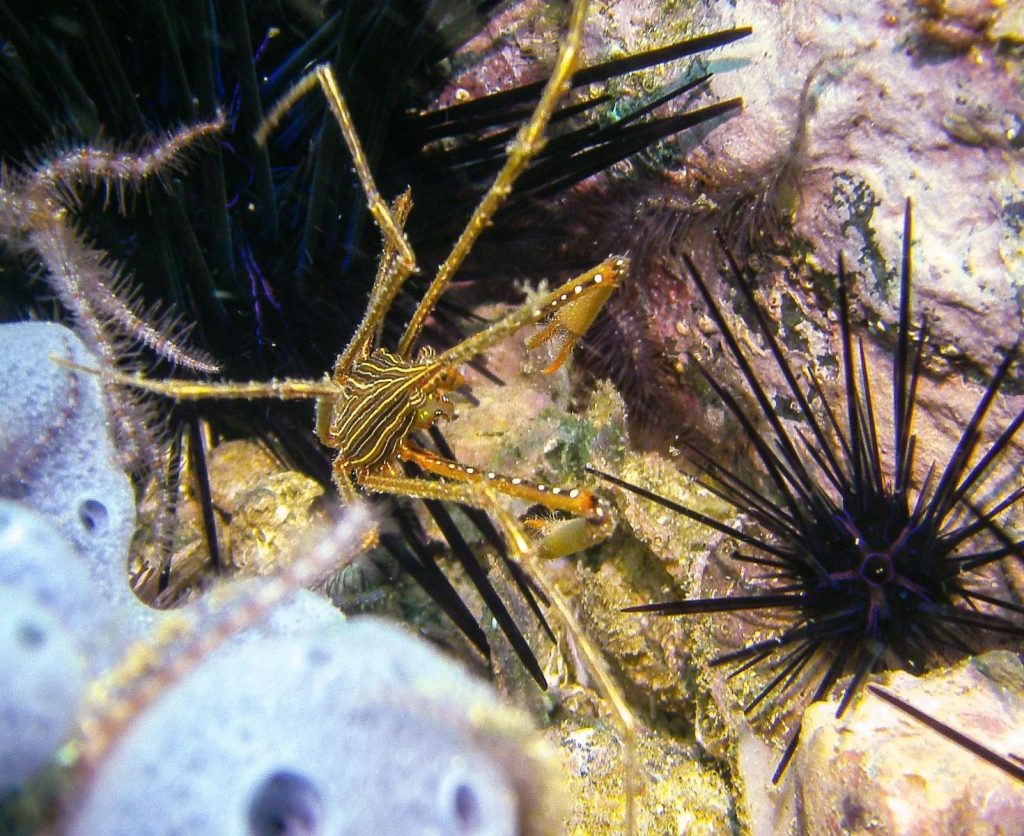
They are nocturnal, searching for their food at night. They scavenge the reefs for algae, worms and other invertebrates and dead organisms.
When mating, the male places a sperm packet into the female by holding her against his belly. The eggs are carried under the female’s abdomen until they hatch. The newly hatched young are called zoea and will retain this name throughout their larval stage of growth. During this time, they have rounded, transparent bodies and live in open water, feeding on small plankton. As they grow, they molt and enter a new stage, megalops. It is during this stage that their body and limbs begin to have a crab-look form.
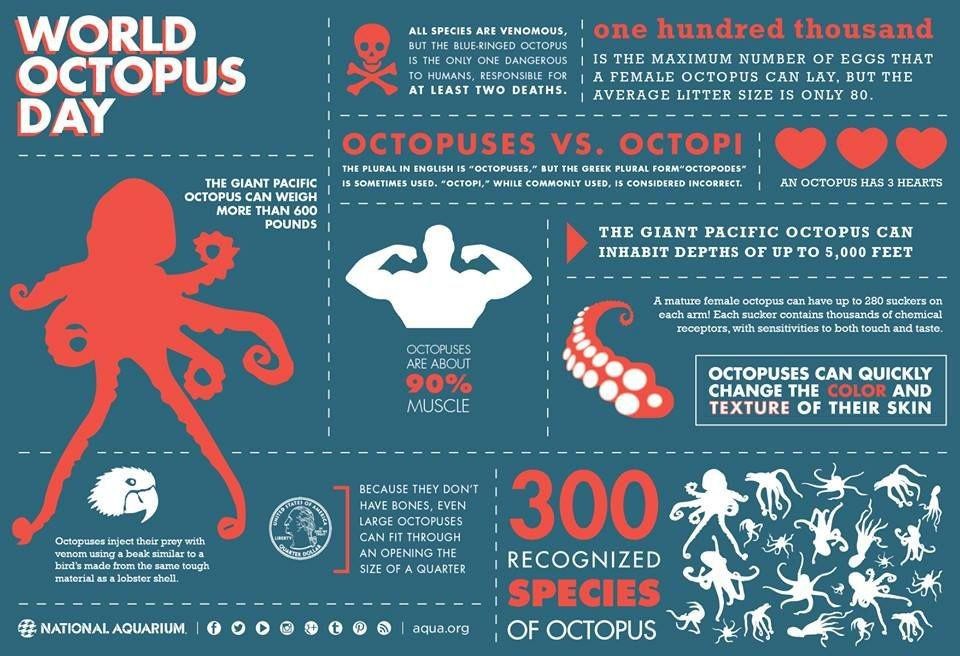
Octopus
These incredible invertebrates often have an arm spread of about 300 cm (9 feet) with the average closer to 30 cm (1 foot). Range is the entire Pacific Coast. They are soft-bodied, have eight arms and are a mollusk from the class with squid and cuttlefish. There are about 300 species of them around the world.
They have arms, not tentacles, and can instantly change their color, brightness, texture, shape and pattern to match their surroundings. They can rapidly alter their shape, enabling octopuses to squeeze through small gaps. They trail their eight arms behind them as they swim. The siphon, or funnel, is used both for respiration and for locomotion, by expelling a jet of water. The texture of their skin and the siphon is often a way to spot them. They can be very difficult to see but, once you’ve found one, it is easier to see more. Octopuses have a complex nervous system and excellent sight, and are among the most intelligent and behaviorally diverse of all invertebrates.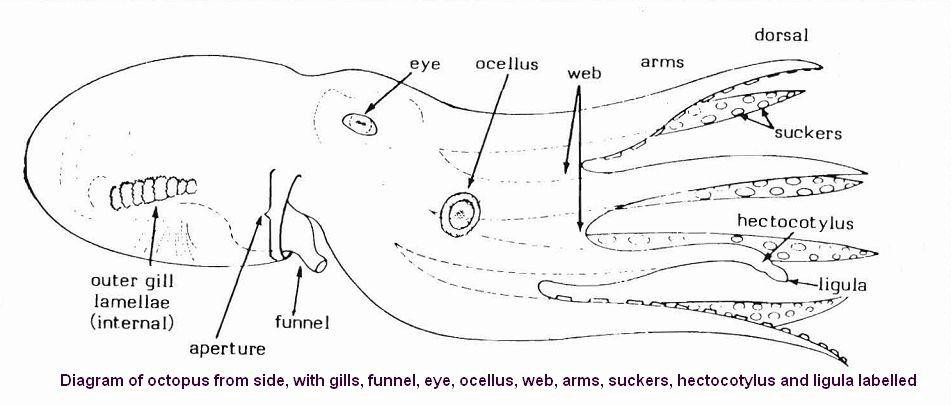
Most species grow fast, mature early and die early. When breeding, the male delivers a sperm “packet” into the female’s cavity. After this, the male dies. The female deposits the fertilized eggs in a den and cares for them until they hatch. Once hatched, the female dies.
They defend themselves by releasing ink, camouflage and threat displays. They can jet through the water quickly and have an incredible ability to hide. They are all venomous but the blue-ringed octopus is the only one known to be deadly to humans. It is always a great thrill to see one, especially if they are out in the open!
Simply talking about changing colors and textures doesn’t do justice to actually watching this happen. So take a look here at this video.
Sea Horses
Sea Horses are in the category of odd-shaped swimmers. We have only one type here in the Eastern Pacific, the Pacific Sea-horse. Size ranges from 4-8 inches (10–20cm) or 12 inches (30cm) maximum. They inhabit depths from 10-60 feet (3-18m). Their colors vary from gray, brown, red and gold.They are solitary and curl their tail around branches of gorgonians, coral and rocks. Sometimes they swim or float free. They do allow a close approach and rarely move, but when a diver comes near they turn their back and tuck their heads down making them difficult to spot.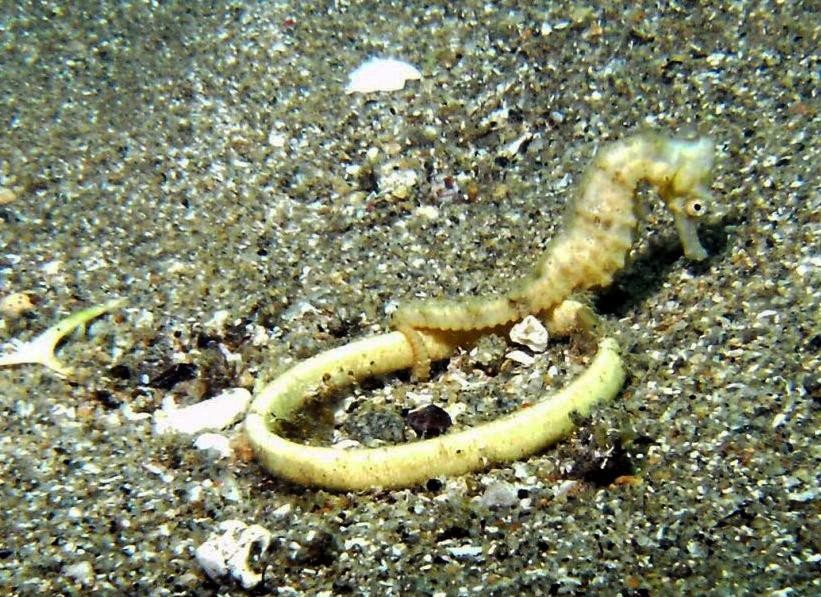
Seahorses are truly unique. They are monogamous and mate for life! They are among the only animal species on Earth in which the male bears the unborn young! Male seahorses have a brood pouch on their front-facing side. The female deposits her eggs into the pouch and the male fertilizes them. He carries the eggs until they hatch, then releases fully formed, miniature seahorses into the water.
Because of their body shape, they are not good swimmers and, when caught in stormy seas, may die from exhaustion. They propel themselves by using a small fin on their back that flutters up to 35 times per second. Even smaller pectoral fins located near the back of the head are used for steering. They tend to anchor themselves with their tail to sea grass, corals and rocks. They use their long snout to suck in plankton and small crustaceans that drift by. Big eaters! They can consume 3,000 or more brine shrimp per day!
Download the full edition or view it online
—
Terry is a founding partner and scuba instructor for Aquatic Sports and Adventures (Deportes y Aventuras Acuáticas) in Manzanillo. A PADI (Professional Association of Dive Instructors) Master Instructor in his 36th year as a PADI Professional. He also holds 15 Specialty Instructor Course ratings. Terry held a US Coast Guard 50-Ton Masters (Captain’s) License. In his past corporate life, he worked in computers from 1973 to 2005 from a computer operator to a project manager for companies including GE Capital Fleet Services and Target. From 2005 to 2008, he developed and oversaw delivery of training to Target’s Loss Prevention (Asset Protection) employees on the West Coast, USA. He led a network of 80+ instructors, evaluated training, performed needs assessments and gathered feedback on the delivery of training, conducted training in Crisis Leadership and Non-Violent Crisis Intervention to Target executives. Independently, he has taught hundreds of hours of skills-based training in American Red Cross CPR, First Aid, SCUBA and sailing and managed a staff of Project Managers at LogicBay in the production of multi-media training and web sites in a fast-paced environment of artists, instructional designers, writers and developers, creating a variety of interactive training and support products for Fortune 1000 companies.
